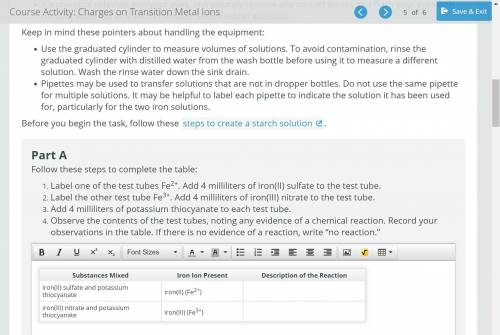
Chemistry, 05.02.2021 20:10 lovelyheart5337
Label one of the test tubes Fe2+. Add 4 milliliters of iron(II) sulfate to the test tube.
Label the other test tube Fe3+. Add 4 milliliters of iron(III) nitrate to the test tube.
Add 4 milliliters of potassium thiocyanate to each test tube.
Observe the contents of the test tubes, noting any evidence of a chemical reaction. Record your observations in the table. If there is no evidence of a reaction, write “no reaction.”


Answers: 1


Another question on Chemistry


Chemistry, 22.06.2019 09:20
Which of these statements explains the difference between nuclear binding energy and the strong nuclear force ?
Answers: 3

Chemistry, 22.06.2019 16:00
How will the volume of a gas be affected if the pressure is tripled, but the temperature remains the same?
Answers: 3

Chemistry, 22.06.2019 19:20
For a research project, a student decided to test the effect of the lead(ii) ion (pb2+) on the ability of salmon eggs to hatch. this ion was obtainable from the water‐soluble salt, lead(ii) nitrate, which the student decided to make by the following reaction. pbo(s) + 2 hno3(aq) → pb(no3)2(aq) + h2o losses of product for various reasons were expected, and a yield of 86.0% was expected. in order to have 5.00 g of product at this yield, how many grams of pbo should be reacted? (assume that sufficient nitric acid, hno3, would be used.)
Answers: 1
You know the right answer?
Label one of the test tubes Fe2+. Add 4 milliliters of iron(II) sulfate to the test tube.
Label the...
Questions






















